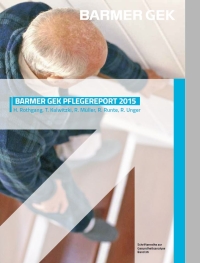 Cover Pflegereport 2015 (Report on long-term care in Germany)
Cover Pflegereport 2015 (Report on long-term care in Germany)The analysis of home care is the special focus of this year's BARMER GEK Long-Term Care Report (Pflegereport 2015), which was presented on 17th November 2015 at the Federal Press Conference. This is the eighth Long-term Care Report drawn up by a team of authors headed by Professor Heinz Rothgang at SOCIUM, University of Bremen. In addition to the special focus topic, the authors - Thomas Kalwitzki, Rolf Müller, Rebecca Runte and Rainer Unger - also examine key developments in long-term care. The study draws on official statistics comprising about 2.6 m. people in need of long-term care (LTC), the German Socio-Economic Panel (SOEP) and routine data provided by the BARMER GEK, whose membership comprises around ten per cent of the population, as well as questionnaires from a total of 1,850 respondents.
Very few allowances claimed for home alterations, though homes of 50% of people in need of care are not barrier-free
The homes of more than half of all beneficiaries of long-term care insurance (LTCI) in Germany living at home are not barrier-free. One would therefore expect more extensive use to be made of LTCI home alteration allowances - which can amount to up to €4,000 per case - to enable people in need of LTC to stay at home as long as possible; all the more so when one considers that over 97 % of questionnaire respondents who received allowances state that this money was extremely helpful. In fact, only about 3.5 % per year of care receivers living at home (65,000) took advantage of this allowance. The six home alterations carried out most frequently were (in descending order): level-access showers, stairlifts, handrails, toilet adaptations, hand grips, ramps.
There are two main reasons why so few people apply for home alteration allowances. The first is that 72 % of the respondents had to make co-payments, which may certainly have been a deterrent for many. On 1st January 2015 the allowance was increased from €2,557 to €4,000, reducing the amount of money applicants have to pay themselves. If the increase had taken effect in 2014, only half of applicants would have had to make co-payments. The second reason is that information about the allowances is not sufficiently communicated. Only half of the respondents received the relevant information from their insurance funds, the Medical Review Board, LTC providers or care support centres (Pflegestützpunkte). About one third of respondents who did not apply stated that they had no knowledge of such allowances. Almost half of the respondents who paid for alterations out of their own pocket did not know that care insurance allowances existed. Clearly there is an information deficit in this respect.
Second Act to Strengthen Long-term Care (PSG II) - a very generous reform
The central improvement brought about by the PSG II is the new definition of entitlement to long-term care benefits. The Act is unexpectedly generous in many respects. Firstly, the new assessment procedure comprises amendments that mean more people will be eligible for care and at the same time more people will qualify for a higher care category. Secondly, of the three proposals made by the Advisory Board for the transition of people already eligible for LTC from (the old) care levels to (the new) care grades, the most generous proposal was selected. Thirdly, the benefit amounts for the new care grades have been laid down in such a way that the benefits that had expressly been defined as transitional under the Long-Term Care Redirection Act (Pflege-Neuausrichtungsgesetz) have now been made permanent - not just for persons with limited daily living skills, i.e. mostly people with dementia, but for all persons in need of LTC.
Last but not least, comprehensive provisions have been made to safeguard existing amounts of benefits. As a result, more than 95 % of those receiving care at home on the date the new legislation came into force are better off, and none are worse off. In the long run, there are only very few people who will on balance be worse off under the new system than under the old one.
Number of people in need of care growing at a faster rate than anticipated; more men in need of care than women; increase in the number of very elderly people in need of care
On the basis of the 2011 census and the recent 13th Federal Statistical Office's Coordinated Population Projection, the number of people in need of LTC by the year 2060 (2055) will have grown to 4.52 m. (4.64 m.), i.e. 221,000 (164,000) more than in earlier projections. Of the additional cases, it is assumed that 176,000 will be men and 'only' 45,000 will be women. From 2040 on a dramatic increase in the number of very elderly people in need of LTC is expected. While in 2015 around 30 % of men in need of LTC were 85 years and older, this figure will increase to around 60 % by the year 2060. There will also be a significant increase in the number of very elderly women. While in 2015 around 50 % of women in need of long-term care are aged 85 and over, this figure is expected to rise to nearly 70 % by 2060. One of the dominant issues of the future will thus be the long-term care of the very elderly and the provision of adequate care structures.
Contact:
Prof. Dr. Heinz Rothgang
SOCIUM Research Center on Inequality and Social Policy
Mary-Somerville-Straße 3
28359 Bremen
Phone: +49 421 218-58557
E-Mail: rothgang@uni-bremen.de











